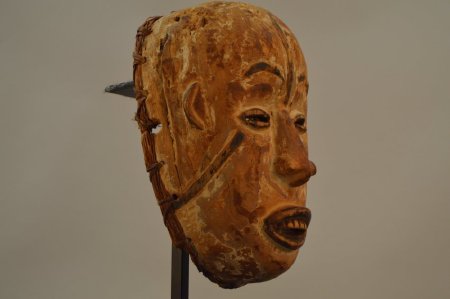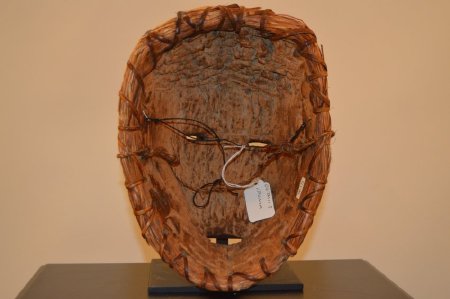Title:
Idoma Dance Mask
Object Name:
Mask, Dance, Idoma
Other Name:
Mask, Face, Idoma, Ikpobi
Place of Origin:
Idoma, Nigeria, Africa
Provenance:
Aboriginal Indigenous Art.
Anthropomorphic face masks are used both by the northern Igbo and by the southern Idoma. Among the Idoma, Ikpobi masks belong to younger men's age—grade associations. This masquerading tradition presumably emerged from the dances once performed by warriors returning home from battle and presenting their enemies' heads as trophies to the village. The age—grades lost their military function with the onset of the colonial period, and such victory celebrations ceased. Today Ikpobi maskers appear primarily at funeral ceremonies, and always in male—female pairs.
Herzog, African Masks, P. 58
Anthropomorphic face masks are used both by the northern Igbo and by the southern Idoma. Among the Idoma, Ikpobi masks belong to younger men's age—grade associations. This masquerading tradition presumably emerged from the dances once performed by warriors returning home from battle and presenting their enemies' heads as trophies to the village. The age—grades lost their military function with the onset of the colonial period, and such victory celebrations ceased. Today Ikpobi maskers appear primarily at funeral ceremonies, and always in male—female pairs.
Herzog, African Masks, P. 58
Description:
Oval—shaped wooden face mask. Narrow slit coffeebean—shaped eyes, slightly open protruding mouth containing row of top teeth. Large full lips and nose. Scarification marks running vertically over middle of forehead and each cheek, starting just under eyes. Dark brown wood (possibly brown patina), with white, black and light tan paint covering entire facial area. Woven raffia circling entire outer back ring of mask.
Collection:
Guy Mace Collection, (Turblex Company)
Material:
Wood W/Paint and Raffia
Used:
Ritually Used
Technique:
Carving / Painting / Weaving
Owned:
Art Department, MSSU
Accession#:
2015.2.3



